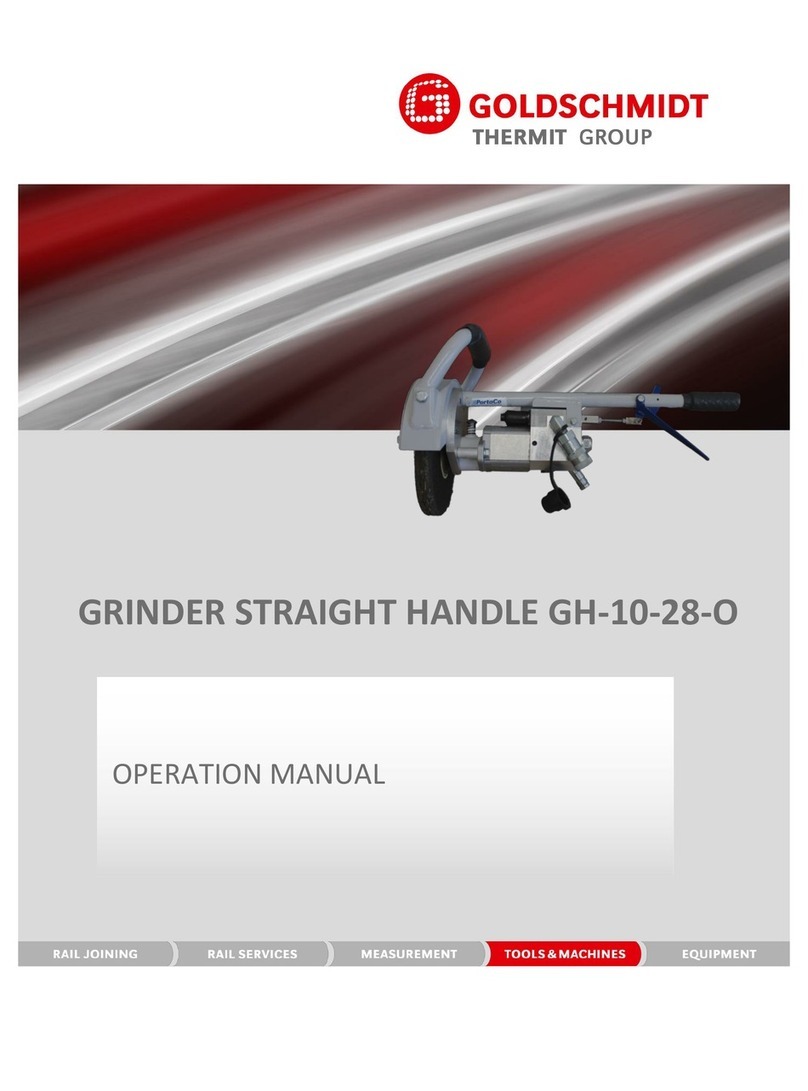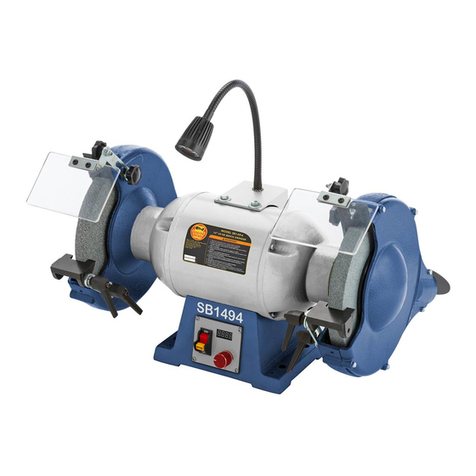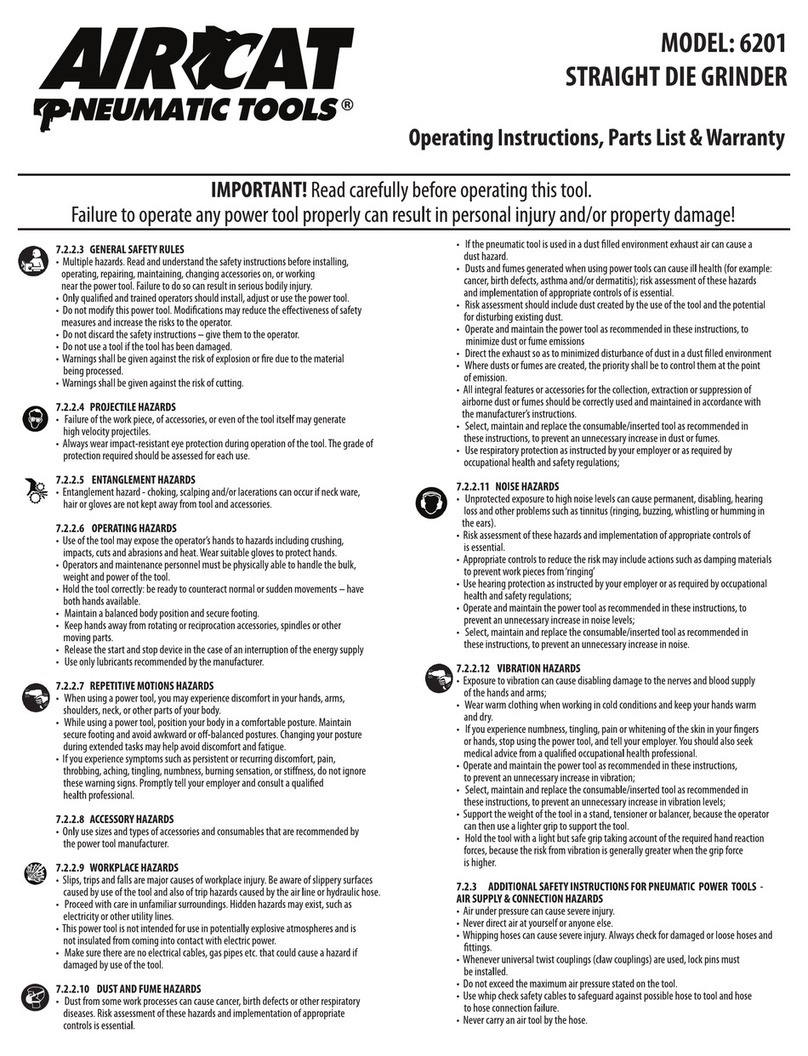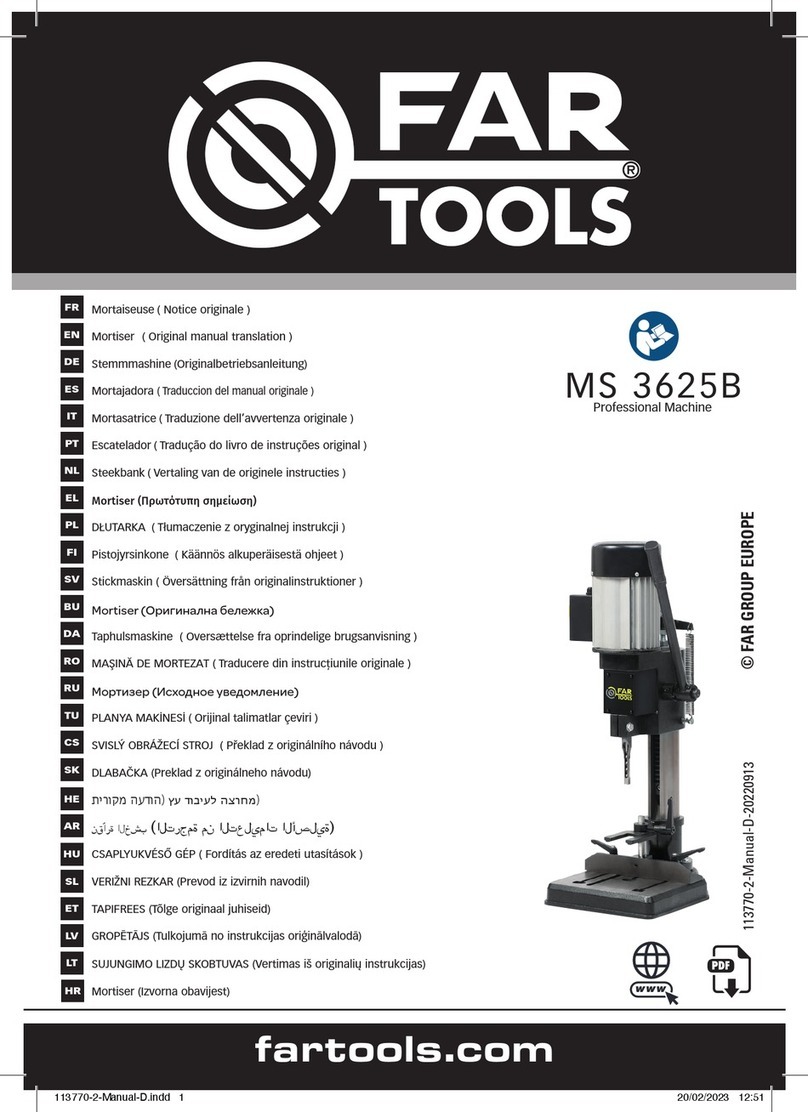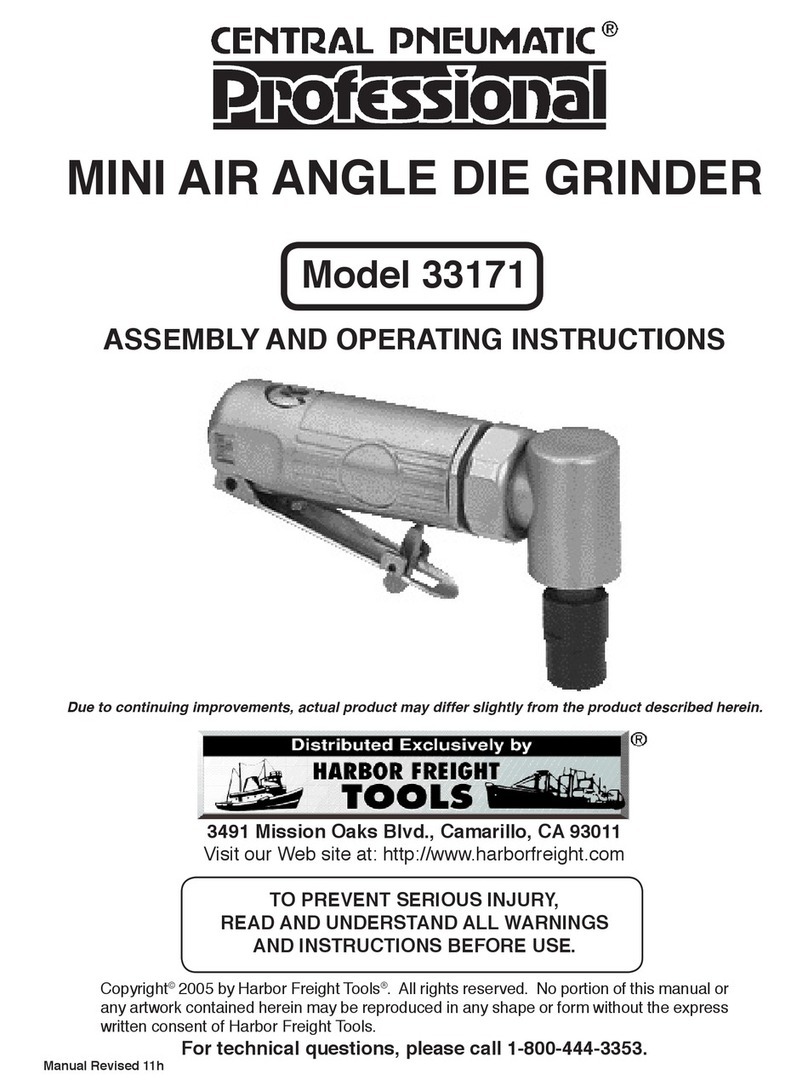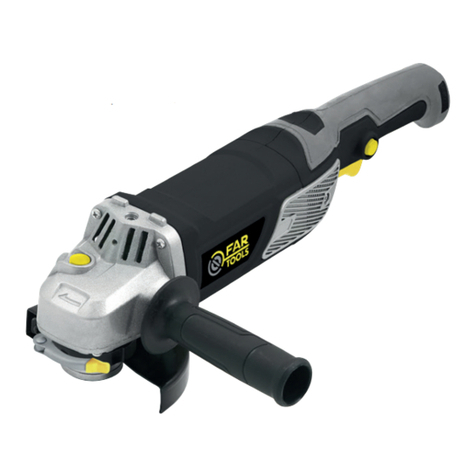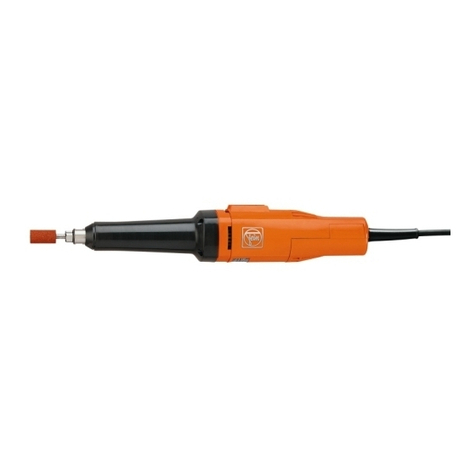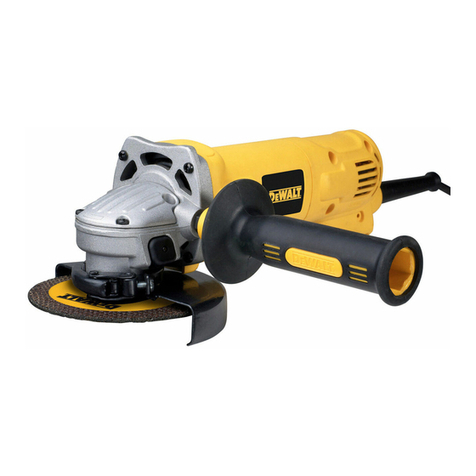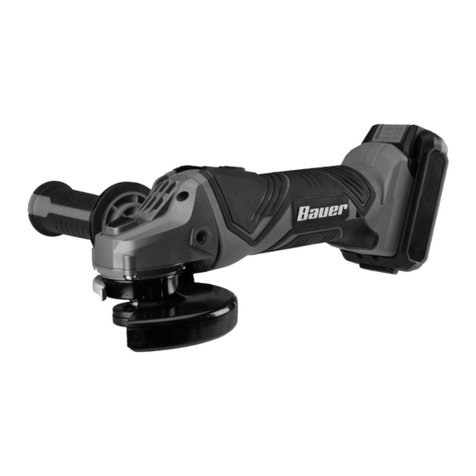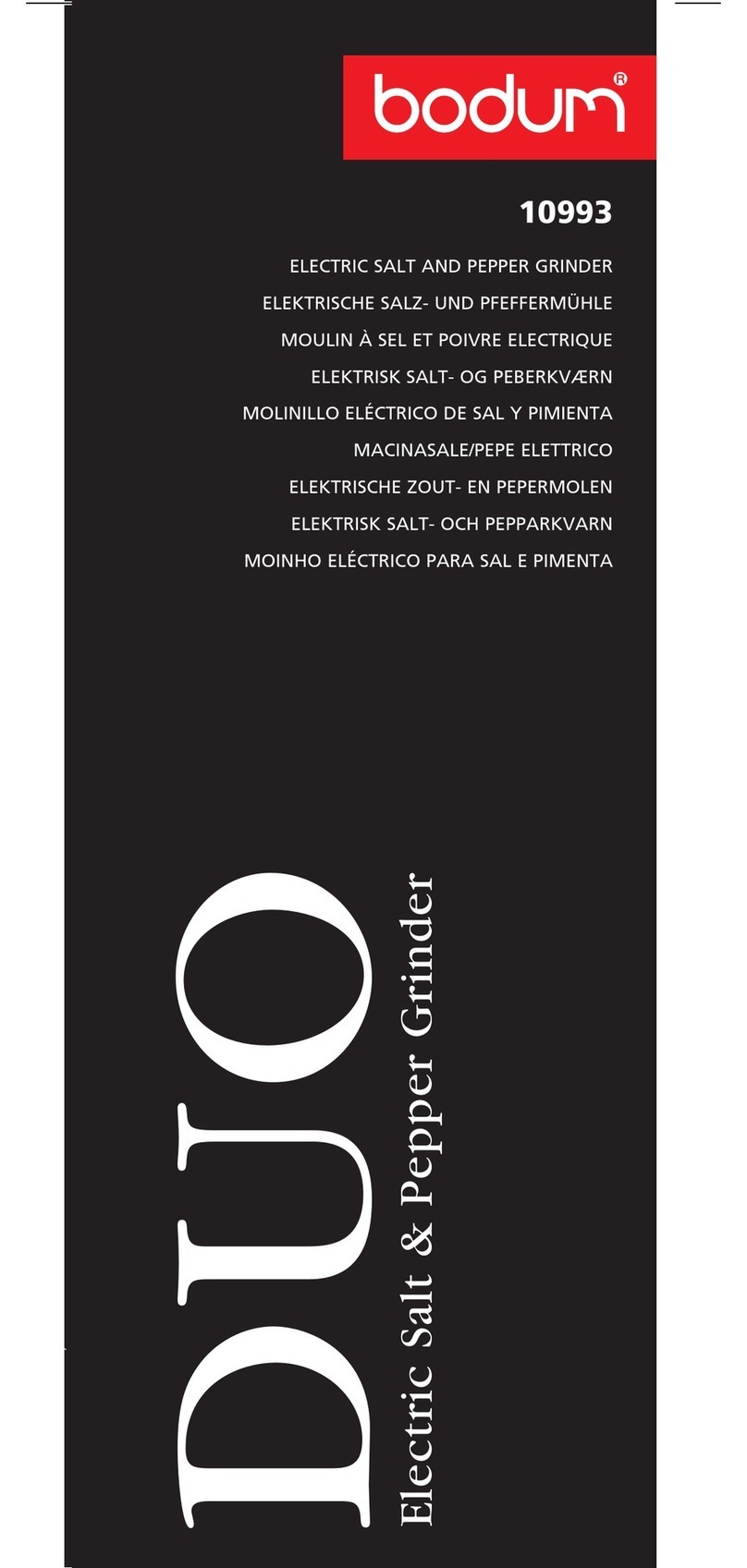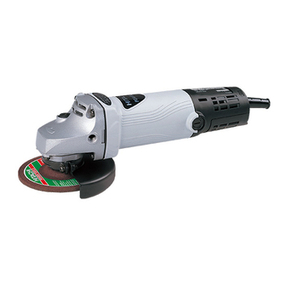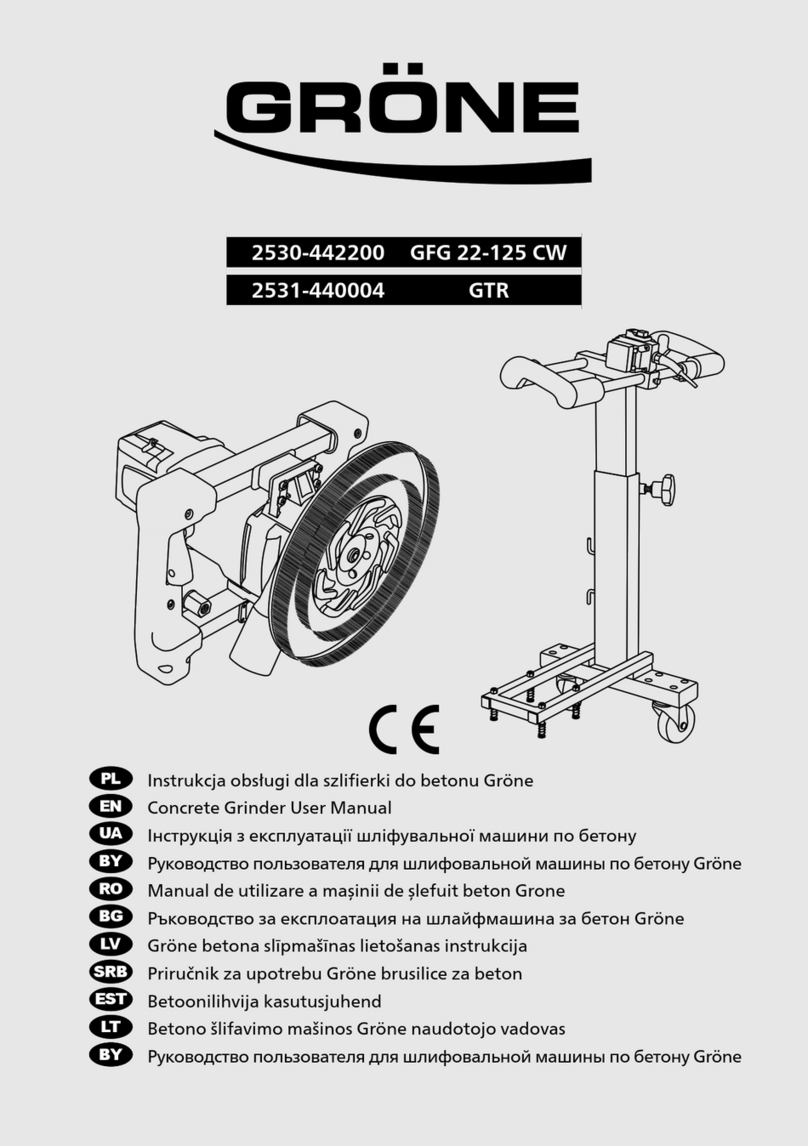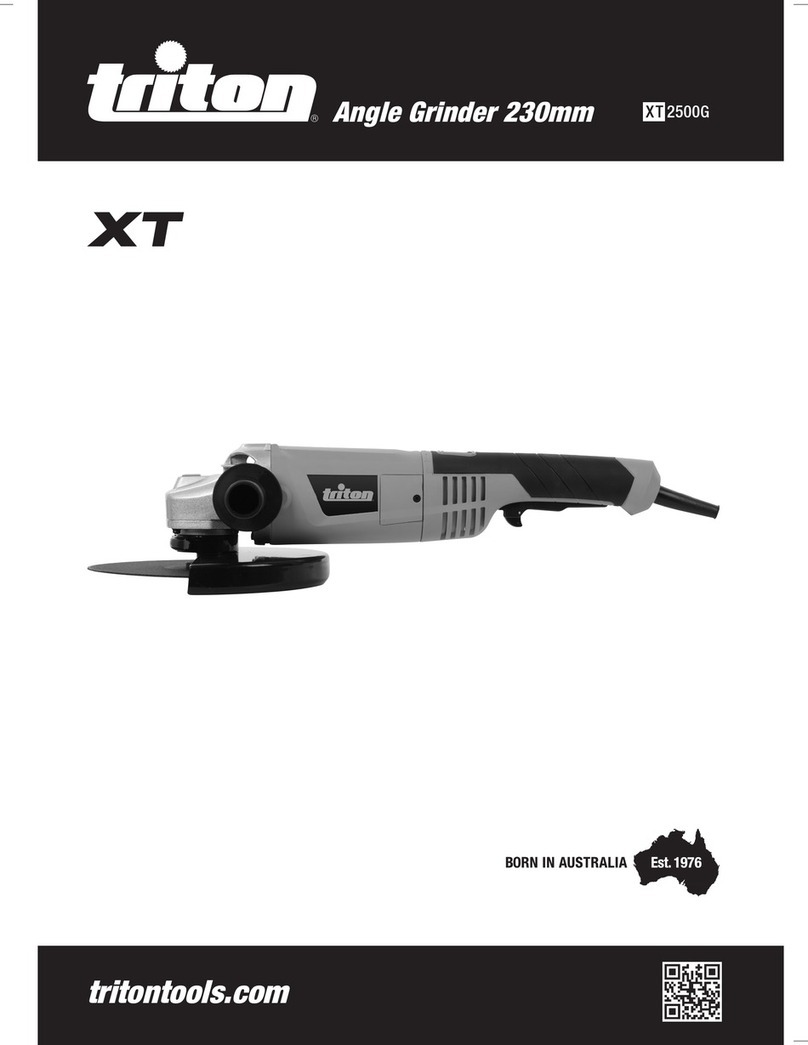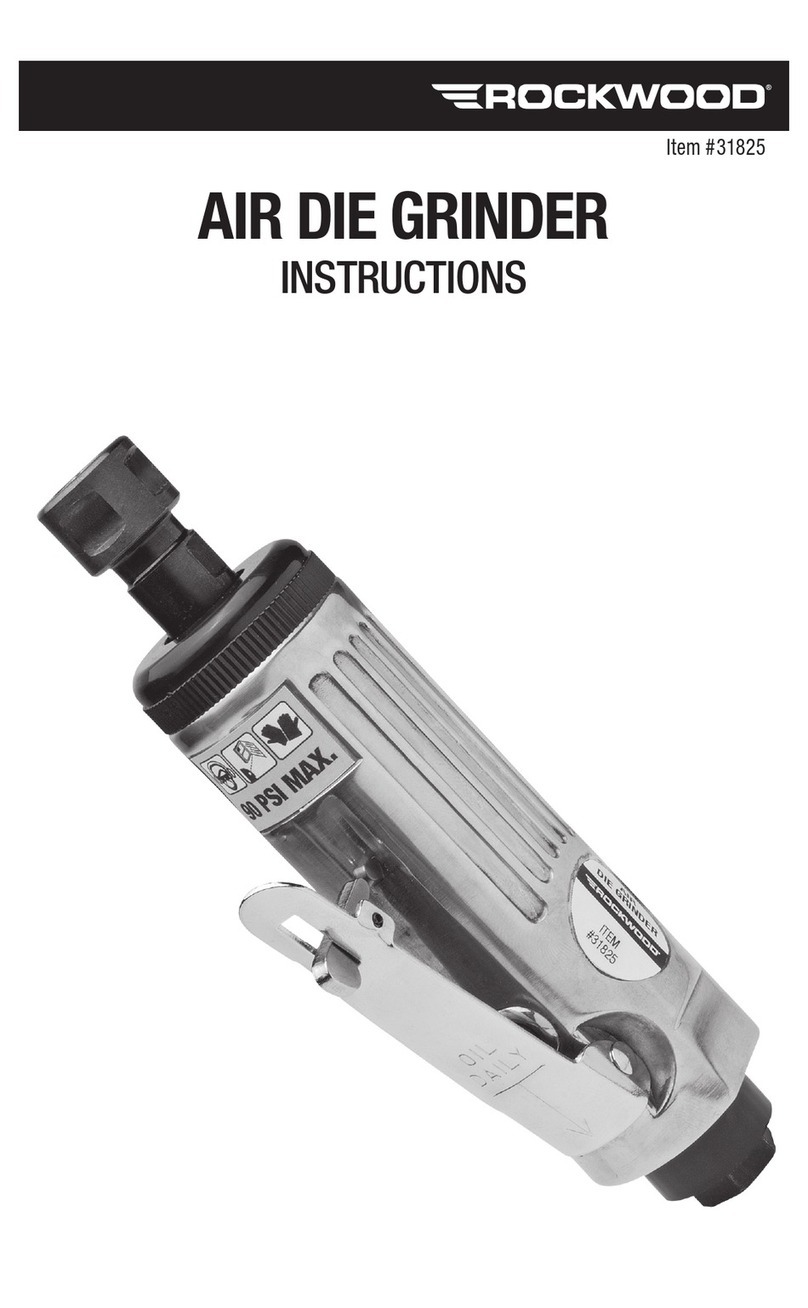Goldschmidt GP 3600 P4 User manual

GP 3600 P4
PROFILE GRINDER
TRANSLATION OF THE ORIGINAL OPERATION MANUAL

PROFILE GRINDER GP 3600 P4 TRANSLATION OF THE ORIGINAL OPERATION MANUAL
Rev. 00 01/12/2022
Page 2 of 41
Revision history
REVISION
DATE
COMMENTS, AFFECTED SECTIONS/CHAPTERS
Approval
00
2022-12-01
First version
Product management

PROFILE GRINDER GP 3600 P4 TRANSLATION OF THE ORIGINAL OPERATION MANUAL
Rev. 00 01/12/2022
Page 3 of 41

PROFILE GRINDER GP 3600 P4 TRANSLATION OF THE ORIGINAL OPERATION MANUAL
Rev. 00 01/12/2022
Page 4 of 41
1. Notes about the operation manual .......................................................................................... 6
1.1 Using the operation manual ............................................................................................................... 6
1.2 Copyright ............................................................................................................................................ 6
1.3 Trademark use.................................................................................................................................... 6
1.4 Warranty............................................................................................................................................. 6
1.5 Product identification of type plate.................................................................................................... 7
1.6 Signal words and symbols used in this operation manual .................................................................. 8
2. Information about your safety ................................................................................................. 9
2.1 Intended use....................................................................................................................................... 9
2.2 Non-intended forms of use................................................................................................................. 9
2.3 Further regulations............................................................................................................................. 9
2.4 General sources of hazard .................................................................................................................. 9
2.5 Danger to life .................................................................................................................................... 10
2.5.1 Danger to life when working on railway tracks ................................................................... 10
2.5.2 Risk to life from electric shock............................................................................................. 10
2.5.3 Risk of injury........................................................................................................................ 10
2.5.4 Risk of burns........................................................................................................................ 11
2.5.5 Risk of environmental pollution .......................................................................................... 11
2.6 Safety signage................................................................................................................................... 12
2.7 General code of conduct................................................................................................................... 13
2.8 Personnel skills levels ....................................................................................................................... 13
2.8.1 Operating company............................................................................................................. 13
2.8.2 Operating personnel............................................................................................................ 13
2.8.3 Maintenance personnel ...................................................................................................... 14
2.9 Personal protective equipment ........................................................................................................ 15
2.10 Safety equipment and safety systems .............................................................................................. 16
2.11 Fire extinguisher ............................................................................................................................... 16
2.12 Behaviour in case of an emergency .................................................................................................. 16
3. Description of device.............................................................................................................. 17
3.1 Description of function ..................................................................................................................... 17
3.2 Overall design ................................................................................................................................... 18
3.3 Scope of delivery .............................................................................................................................. 19
4. Technical data ........................................................................................................................ 19
5. Operating conditions.............................................................................................................. 20
6. Transport ............................................................................................................................... 21
6.1 Lifting fixtures on the machine ......................................................................................................... 21
6.2 Transport operation.......................................................................................................................... 21
7. Operation............................................................................................................................... 23
7.1 Control and setting elements ........................................................................................................... 23
7.2 Commissioning.................................................................................................................................. 25

PROFILE GRINDER GP 3600 P4 TRANSLATION OF THE ORIGINAL OPERATION MANUAL
Rev. 00 01/12/2022
Page 5 of 41
7.3 Setting the rail guide......................................................................................................................... 25
7.4 Starting the machine ........................................................................................................................ 26
7.5 Operating the machine correctly...................................................................................................... 27
7.5.1 Grinding the running surface............................................................................................... 29
7.5.2 Grinding the running edge................................................................................................... 31
7.5.3 Replacing the cup grinder.................................................................................................... 32
7.5.4 Setting the rupture protection ............................................................................................ 33
7.5.5 Adjusting the control arm height ........................................................................................ 33
7.6 Switching off the machine ................................................................................................................ 33
8. Maintenance and inspection.................................................................................................. 34
8.1 Cleaning ............................................................................................................................................ 34
8.1.1 Fundamental ....................................................................................................................... 34
8.1.2 Air filter ............................................................................................................................... 35
8.2 Topping up operating fluids and consumables ................................................................................. 35
8.2.1 Checking and topping up fuel.............................................................................................. 35
8.2.2 Checking engine oil, topping up and changing it ................................................................. 36
8.3 Replacing the V-belt.......................................................................................................................... 37
8.4 Inspection ......................................................................................................................................... 38
9. Remedying problems ............................................................................................................. 39
10.Storage................................................................................................................................... 39
11.Disposal ................................................................................................................................. 40
11.1 Disposal of used oil........................................................................................................................... 40
11.2 Disposal of parts containing oil and equipment contaminated with oil ........................................... 40
11.3 Disposal of scrap metal..................................................................................................................... 40
12.List of figures.......................................................................................................................... 41
13.List of tables........................................................................................................................... 41
Publisher:
ELEKTRO-THERMIT GMBH & CO. KG
A GOLDSCHMIDT COMPANY
Chemiestr. 24, 06132 Halle (Saale), Germany
Phone +49 345 7795-600, Fax +49 345 7795-770
Date of publication: 2022-12-01
Documentation version: 2022-12-01
Images: André Straub, Elektro-Thermit GmbH & Co. KG

PROFILE GRINDER GP 3600 P4 TRANSLATION OF THE ORIGINAL OPERATION MANUAL
Rev. 00 01/12/2022
Page 6 of 41
1. Notes about the operation manual
This operation manual contains all the information relating to the intended use and correct servicing and maintenance of the GP
3600 P4 profile grinder.
Please note the following points:
•The operation manual is part of the GP 3600 P4 profile grinder.
•It must remain available throughout the service life of the machine.
•The operation manual must be available to the user and to the maintenance personnel at all times.
1.1 Using the operation manual
The information in this operation manual and the maintenance manual are binding in nature. Anyone carrying out work with the
machine or handling the machine in any other way must first read and understand the operation manual in full. Follow the
instructions, prohibitions and commands in the operation manual at all times, as well as all safety instructions.
1.2 Copyright
This operation manual is protected by Elektro-Thermit GmbH & Co. KG copyright. Reproduction of this document, whether wholly
or in part and/or its dissemination to third parties requires the prior written consent of Elektro-Thermit GmbH & Co. KG.
1.3 Trademark use
The names of companies and products used in this document may be registered trademarks of their respective owners.
1.4 Warranty
The legally stipulated obligation governing the warranty period applies. The warranty does not cover damage caused by wear
resulting from use of the machine. Elektro-Thermit GmbH & Co. KG accepts no responsibility or warranty and will refute any
possible claims from third parties if personal injury or damage to property is due to one or more of the following causes by the
operator or a third party:
•non-intended use of the machine,
•failure to follow the instructions in this operation manual,
•failure to comply with specified limits and conditions for use,
•incorrect commissioning, operation, inspection or maintenance of the machine,
•failure to comply with specified servicing and maintenance intervals,
•modifications to the machine or to individual components that were not expressly authorised by the manufacturer or
•use of non-approved accessories or spare parts.

PROFILE GRINDER GP 3600 P4 TRANSLATION OF THE ORIGINAL OPERATION MANUAL
Rev. 00 01/12/2022
Page 7 of 41
1.5 Product identification of type plate
A type plate is attached to the machine that provides precise identification of the machine. The operating company must ensure
that this type plate is replaced in the event of damage or loss. The details on the type plate must always be quoted in any
correspondence with the manufacturer or with customer service.
Figure 1: Type plate
The type plate can be found at this location:
Figure 2: Type plate location

PROFILE GRINDER GP 3600 P4 TRANSLATION OF THE ORIGINAL OPERATION MANUAL
Rev. 00 01/12/2022
Page 8 of 41
1.6 Signal words and symbols used in this operation manual
When using this operation manual, pay attention to the symbols and abbreviations used. The safety symbols are based on the ISO
3864 standard and are identical to the safety signs attached to the machine (→ chapter 2.6 Safety signage).
SYMBOL
DESCRIPTION
DANGER
The signal word DANGER indicates a hazard with a high level of risk that, if not avoided, may result in death
or serious injury.
WARNING
The signal word WARNING indicates a hazard with a medium level of risk that, if not avoided, may result in
serious injury.
CAUTION
The signal word CAUTION indicates a hazard with a low level of risk that, if not avoided, may result in minor
or moderate injury.
NOTICE
The signal word NOTICE indicates a hazard that, if not avoided, may result in damage to property or the
environment.
The info symbol indicates information (tips, recommendations, remarks, etc.) that may be helpful for
handling the product.
Situations with a risk of injury are additionally marked with a warning sign.
Table 1: Signal words and symbols

PROFILE GRINDER GP 3600 P4 TRANSLATION OF THE ORIGINAL OPERATION MANUAL
Rev. 00 01/12/2022
Page 9 of 41
2. Information about your safety
This chapter contains all the information relating to safety. Read all safety information thoroughly before using the machine and
follow it carefully when operating it. The safety instructions draw attention to hazards of possible personal injury, property damage
and environmental damage and contain information on how to avoid and prevent hazards. The presentation and content structure
of the safety instructions are based on the ISO 3864 and EN IEC/IEEE 82079 standards.
2.1 Intended use
The machine must always be operated in strict compliance with the specified operating conditions.
→ Chap. 5 Operating conditions
The GP 3600 P4 profile grinder is suitable for the accurate profile grinding of butt welds, running surfaces, rail head roundings and
the side surface of steel rails with vignole profile as well as groove profile in manual operation without the use of cooling lubricants.
Any other use of the machine or of its components, or any more extensive form of use, constitutes 'non-intended use'. The
machine can be used on flat-bottom rails from rail profile 46E1 as well as on grooved rails from rail profile 51Ri1. Please contact the
manufacturer to find out whether the machine can be used on smaller rail profiles.
The manufacturer accepts no liability for damage resulting from improper use.
2.2 Non-intended forms of use
Intended use exists if the machine is used for a different purpose that that described in → Chap. 2.1 Intended use.
Examples of intended use are:
•Grinding of other objects or materials than the defined rail profiles.
•Using the machine to drive other devices.
•Using the machine as a means of transport.
•Using the guidance system on the machine as wheels for transport.
2.3 Further regulations
In addition to the information in this operation manual, due compliance is mandatory with the statutory regulations for accident
prevention and environmental and occupational safety as well as the accident prevention regulations of the operating company.
Strict compliance is also required with the safety regulations issued by the railway authorities for working on and near the tracks.
2.4 General sources of hazard
The machine is designed to state-of-the-art standards. It is not possible to eliminate residual risks. Pay attention to the following
safety instructions when using the machine.

PROFILE GRINDER GP 3600 P4 TRANSLATION OF THE ORIGINAL OPERATION MANUAL
Rev. 00 01/12/2022
Page 10 of 41
2.5 Danger to life
2.5.1 Danger to life when working on railway tracks
During track construction work, there is always a risk of people being hit by passing trains, causing extremely severe injuries.
•Before working on the track bed, always ensure that the track has been closed off to permit that work. Never work on a track
that is open for rail traffic.
•Always proceed with great caution whenever the construction site is close to railway tracks open to rail traffic.
•Always set down equipment and materials in a place where they cannot collide with other rail vehicles.
2.5.2 Risk to life from electric shock
There is a risk of serious injury from electric shock when working on live parts and cables. This can lead to ventricular fibrillation,
cardiac arrest or respiratory paralysis with a fatal outcome.
•Never use the machine if a conductor rail at the work site is live.
•Never use this machine on a conductor rail that is electrically live at the time.
•Always ensure that there is no risk of electric shock.
2.5.3 Risk of injury
Risk of injury from the crushing of body parts
If people's limbs are under the grinding wheel or under the guide system when working with the machine, there is a risk of serious
injury from crushing possibly involving broken bones or even the severing of entire limbs.
•When operating this machine, never place hands or feet below the grinding head or under the guide system.
•Always wear sturdy protective work shoes of protection class S3.
•Always wear work gloves.
•Everyone except for the operator must maintain a safe distance of at least 5 metres from the machine while it is switched on.
Risk of injury from projectile gravel and dust when cleaning the air filter
Working with compressed air entails the risk of dust particles and splinters getting into the eyes. This can injure them or may even
cause blindness. Always wear safety goggles when working with compressed air and in the vicinity of others working with it.
Risk of injury from falling, slipping and sliding
When working on the track bed, there is a risk of slipping and falling on the gravel, causing injuries such as contusions or even
broken bones.
•When working with the machine, always maintain a firm stance.
•Do not work with the machine on a gradient of more than 10°.
•Wear work gloves in protection class S3.
Risk of damage to hearing
The A-weighted emission sound pressure level LPA at the workplace can be up to 74 dBA and the A-weighted emission noise level
LWA at the workplace can be up to 85 dBA. Exposure to noise can damage hearing and lead to short-term hearing loss and mental
overload. Always wear ear defenders when working with this machine.

PROFILE GRINDER GP 3600 P4 TRANSLATION OF THE ORIGINAL OPERATION MANUAL
Rev. 00 01/12/2022
Page 11 of 41
2.5.4 Risk of burns
Explosive or combustible materials
Explosions or fires can cause serious burn injuries.
•Never perform grinding operations in environments where there is a risk of explosion or fire.
•Always ensure that there are no highly flammable or explosive substances near the machine.
•If necessary, remove combustible substances from the work place and provide sufficient ventilation.
Refuelling the machine
During refuelling, if fuel spills over the machine, there is a risk of explosion or fire when the machine is next started, potentially
causing severe burns.
•Never refuel the machine while the engine is hot. Let the engine cool down before refuelling.
•If necessary, clean the machine carefully and remove any fuel that may have escaped. Ensure that the surrounding area is
properly ventilated whenever the machine is restarted.
Hot engine
During normal operation and after being switched off, the engine can be very hot, potentially causing burn injuries.
•Avoid contact with the engine shortly after it has been in operation.
•Before maintenance work on the engine, assure sufficient cooling time.
•Always wear protective work clothing, especially work gloves, when working on the machine.
2.5.5 Risk of environmental pollution
The machine contains engine oil and is operated by petrol. Mineral-based oils are a water hazard. If petrol or engine oil leaks into
the soil, this can pollute the groundwater causing the infiltration of environmentally hazardous substances into the food chain.
•When refuelling, always ensure that dripping fuel does not enter the ground. If necessary, place collection pans under it.
•Dispose of contaminated cleaning utensils properly.
•Always collect used oil in the containers provided.

PROFILE GRINDER GP 3600 P4 TRANSLATION OF THE ORIGINAL OPERATION MANUAL
Rev. 00 01/12/2022
Page 12 of 41
2.6 Safety signage
Fit safety signage to the machine that complies with the specifications of ISO 7010 and ISO 3864.
Keep safety signage in good condition If safety signage gets damaged or goes missing during the service life of the
machine, the operating company must provide for proper replacement. Check the presence and condition of safety
signage at regular intervals.
The following safety pictograms are attached to the machine:
PICTOGRAM
MEANING
PICTOGRAM
MEANING
Naked flames, fire and ignition
sources are prohibited near
the machine
Personal protective equipment
Smoking is prohibited near the
machine
Caution - crushing hazard
Only lift the machine at these
points
Table 2: Safety signage
Figure 3: Attachment point for safety signage
2
1
4
3
2
2
4
1
1
3
4

PROFILE GRINDER GP 3600 P4 TRANSLATION OF THE ORIGINAL OPERATION MANUAL
Rev. 00 01/12/2022
Page 13 of 41
2.7 General code of conduct
The personnel must observe this code of conduct at all times when working on the machine:
•The machine should only ever be used in the intended manner.
•When working on the machine, always pay attention to personal safety and to the safety of others, and to cleanliness and
tidiness.
•Follow all instructions from the operating company.
2.8 Personnel skills levels
Without exception, all people working on or with the machine must satisfy the following requirements. All other people are
prohibited from working on or with the machine.
•Before using the machine, they must have read and fully understood the entire scope of this operation manual.
•You are in perfect health and in full possession of your mental and physical faculties.
•You are rested and not under the influence of drugs, alcohol or medication, which can reduce your ability to react and absorb.
•They are regularly instructed about difficulties, hazards and special rules of conduct as well as about fire protection rules.
They always keep the work place tidy.
•To assure work safety, they wear the requisite personal protective equipment. → Chap. 2.9 Personal protective equipment
•They always observe the employer’s safety and accident prevention regulations and all legal provisions relevant to personal
safety and to the safety of other persons.
2.8.1 Operating company
The operating company is the entity that operates the machine for commercial or business purposes or permits a third party to use
and operate it. The operating company is also legally responsible for the protection of the operator, personnel or third parties.
Obligations of the operating company
•The operating company must know and implement the regulations governing health & safety at work and accident prevention.
•The operating company must clearly regulate and define the responsibilities for proper transport, assembly, operation,
troubleshooting, inspection, maintenance, repair, cleaning and disposal.
•The operating company must also ensure that all personnel have read and fully understood the entire scope of this operation
manual.
•The operating company must provide training for its personnel at regular intervals and inform them of hazards.
•It must provide its personnel with the requisite personal protective equipment.
2.8.2 Operating personnel
The operating personnel for the machine are defined as follows:
•The personnel is professionally and technically capable of performing all operating activities on the machine as well as
troubleshooting and cleaning it.
•Personnel are trained continuously in relation to technical innovations and have the necessary basic understanding of the
technology installed.
•Personnel are professionally and technically capable of all the activities that occur on the machine in the areas listed below:
•operation,
•fault detection,
•cleaning.
•The following key points must be taken into account during initial instruction:
•functional description of the machine,
•explanation of its components,
•explanation of the potential hazards,
•use of the machine,
•detection of faults and malfunctions,
•correct cleaning of the machine.

PROFILE GRINDER GP 3600 P4 TRANSLATION OF THE ORIGINAL OPERATION MANUAL
Rev. 00 01/12/2022
Page 14 of 41
2.8.3 Maintenance personnel
The maintenance personnel is defined as follows.
•Trained specialists in the fields of electrical engineering and mechatronics or trained industrial mechanics, i.e.:
•Trained in the specific field of application in which they operate and familiar with the relevant standards and regulations.
•On the basis of their technical training and experience, the personnel can carry out work on machines powered by petrol
engines and are independently able to identify and avoid potential hazards.
•They are capable of fully understanding interrelationships regarding the built-in safety devices.
•They can read circuit and terminal diagrams and can carry our electrical engineering maintenance work using those circuit
and terminal diagrams.
•They have read and understood the entire scope of the maintenance manual.
•Personnel are professionally and technically capable of all the activities that occur on the machine in the areas listed below:
•installation,
•disassembly,
•operation,
•troubleshooting and remedial work,
•inspection,
•maintenance,
•repair/replacement,
•decommissioning,
•cleaning.
•Personnel receive continuous training on technical innovations and have the necessary expertise to operate the installed
technology.
•The following key points must be taken into account during initial instruction:
•functional description of the machine,
•explanation of its components,
•explanation of the potential hazards,
•use of the machine,
•detection and remedying of faults,
•Special points relating to maintenance and servicing.

PROFILE GRINDER GP 3600 P4 TRANSLATION OF THE ORIGINAL OPERATION MANUAL
Rev. 00 01/12/2022
Page 15 of 41
2.9 Personal protective equipment
Unless the operator specifies otherwise, the protective equipment listed in the following table is mandatory when working with the
machine.
The following protective equipment must be worn during the activities listed under ’Work’ on the machine:
SYMBOL
PROTECTIVE EQUIPMENT
WORKING
Protective work clothing
(welding protective clothing in accordance with EN 470-1, if
necessary warning clothing in accordance with EN 471)
Transport, commissioning,
operation, decommissioning,
maintenance, cleaning/care
Work footwear
(safety footwear S3 in acc. with EN ISO 20345, ankle-high
footwear)
Transport, commissioning,
operation, decommissioning,
maintenance
Protective goggles
Operation
Work gloves
(serious mechanical hazard in acc. with EN 388 (4242), EN 402))
Transport, commissioning,
operation, decommissioning,
maintenance, cleaning/care
Ear defenders
(ear plugs in accordance with EN 352) / EN 458)
Operation
Table 3: Personal protective equipment

PROFILE GRINDER GP 3600 P4 TRANSLATION OF THE ORIGINAL OPERATION MANUAL
Rev. 00 01/12/2022
Page 16 of 41
2.10 Safety equipment and safety systems
The following safety devices are installed on the machine to prevent personal injury, environmental damage and damage to
property. These illustrations show which items of safety equipment are fitted to the machine.
Figure 4: Safety equipment
COMPONENT
(1)
Spark protection
(2)
Rupture protection
Table 4: Safety equipment
Spark protection
The spark protection helps to prevent sparks from flying when grinding the rail head. Instead, sparks are deflected by the operator
and only fly downwards towards the ground to minimise the risk of fire and explosion posed by flying sparks.
Rupture protection
The rupture protection shields the grinding head. If the grinding cup gets damaged during the grinding process, the rupture
protection prevents grinding cup components from getting ejected centrifugally.
2.11 Fire extinguisher
The operating company must ensure that an operational CO2 fire extinguisher is available at all times right beside the workplace.
2.12 Behaviour in case of an emergency
If an emergency occurs, shut down the machine immediately and vacate the danger area as quickly as possible. Immediately
initiate first aid measures in the event of personal injury. In the event of a fire, immediately initiate the required steps for fire-
fighting.
1
2

PROFILE GRINDER GP 3600 P4 TRANSLATION OF THE ORIGINAL OPERATION MANUAL
Rev. 00 01/12/2022
Page 17 of 41
3. Description of device
This chapter illustrates the most important components of the and explains their functions.
This machine is made to state-of-the-art standards. At the design stage, all applicable legislation, regulations, statutory
requirements and directives were observed. All of the required safety precautions were taken, assuring the highest possible level of
personal safety. The materials used, the equipment parts as well as the production, quality assurance and testing procedures meet
the highest safety and reliability requirements.
3.1 Description of function
This machine is used to grind rail heads.
•To satisfy this function, the machine uses a rotary grinding head that is in contact with the rail head.
•The grinding cup is driven by an engine.
•This engine transmits power to the grinding cup via a belt drive.
•The machine is mounted on rollers and is held on the rail by a guide system. The rail guide is suitable for flat-bottom rails and
for grooved rails.
•The guide system can be adjusted to suit different rail profiles. The operator can move the machine along the rail.
•A tipping fixture helps to tilt the grinding cup and the functional components of the machine on the rail head, and to grind the
sides of the rail head.
•A stand allows the machine to be safely parked at the work site without having to lift it off the rail.

PROFILE GRINDER GP 3600 P4 TRANSLATION OF THE ORIGINAL OPERATION MANUAL
Rev. 00 01/12/2022
Page 18 of 41
3.2 Overall design
The machine comprises the following components:
Figure 5: Complete layout of the GP3600 P4
COMPONENT
(1)
Control arm
(2)
Adjustment
(3)
Carrying handle
(4)
Motor with fuel tank
(5)
Grinding spindle
(6)
Machine frame
(7)
Rail guide
(8)
Spark and rupture protection
Table 5: Technical data
4
1
5
7
7
8
6
2
3
3

PROFILE GRINDER GP 3600 P4 TRANSLATION OF THE ORIGINAL OPERATION MANUAL
Rev. 00 01/12/2022
Page 19 of 41
3.3 Scope of delivery
DESIGNATION
AMOUNT
GP 3600 P4
1
Cup grinder 125x65-M20
1
Quick start guide
1
Table 6: Scope of delivery
4. Technical data
This chapter contains all of the important technical data for the machine.
PARAMETERS
PARAMETER VALUE
Length
1,220 mm
Width
375 mm
Height
810 mm
Weight (operational readiness)
50 kg
Roller spacing
850 mm
Motor type
4-stroke petrol motor
Motor manufacturer
Honda
Model
GXR120 Rammer
Fuel
Petrol
Rating
2.3 kW
Motor speed (under load)
3,600 min-1
Tank contents
2.4 l
Noise level
85 dB(A)
Sounds pressure level
74 dB(A)
Hand-arm vibration
10.1 m/s²
Table 7: Technical data

PROFILE GRINDER GP 3600 P4 TRANSLATION OF THE ORIGINAL OPERATION MANUAL
Rev. 00 01/12/2022
Page 20 of 41
5. Operating conditions
This chapter describes the operating conditions needed for the machine to operate properly. Do not operate the machine if real
conditions differ from these operating conditions. Before commissioning the machine, always check that all operating conditions
are met.
CONDITION
VALUE
Ambient temperature
-20 °C to +40 °C
Table 8: Operating conditions
Also, the following conditions need to be satisfied when operating the machine:
•No protective equipment or other components can be shut down.
•The machine must always be operated in technically perfect condition.
•All inspection and maintenance intervals must be complied with.
•The machine must not be operated in an environment where there is a risk of fire or explosion nor in the vicinity of flammable
or explosive liquids or gases.
•The workplace must be illuminated sufficiently to enable potential danger areas to be detected in good time.
•The workplace must be ventilated sufficiently.
•The machine can only be operated in a dry location.
•The machine must not be operated on a gradient of 10° or more.
Table of contents
Other Goldschmidt Grinder manuals
